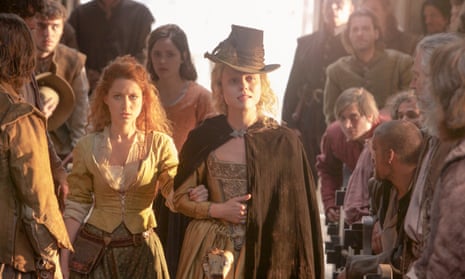“I will not marry your brother so that he can crush the soul out of me!” asserts Alice, the heroine of Jamestown, Sky’s new period drama. Set in 1619, the story follows the lives of three women whose passage to Virginia is paid by English settlers wishing to take them for wives. Over the course of the first episode, one of the women is raped, another publicly wallops her intended husband, and the third schemes behind her fiance’s back. The language the women use is coarse (“dog’s arse”, “shit pants halfwit”, “whore”) and empowered: “A man will hang for raping a woman!”
Already critics have questioned the veracity of the history portrayed. “You wonder if the real 17th-century spouses were as feisty, cheeky and rebellious” as the women depicted in the show, asks Mark Lawson. He suggests that the real history of 17th-century women “willingly accepting sexual and social submission” has been “airbrushed” in favour of themes that are more palatable to modern audiences. So, what was the reality for early modern women? And just how authentic are Jamestown’s female protagonists?
It is certainly true that women of that time were encouraged to be submissive. With a strict moral code dictated by religion, law and even medicine, they were expected to conform to the cultural ideal of a meek and supportive wife, who would bear children, obey her husband and accept the weakness of her nature, manifest in a wet and “leaky” body that was susceptible to sin. Marriage took place when a woman was in her mid-20s and contemporaneous instructions recommended that wives “be content with their condition and not to torment their husbands and themselves with impatient murmurings”. Unless a woman was high born or widowed, she rarely enjoyed the same level of freedom as a man.
Women who did transgress – whether that be public fighting, shouting, cursing or drunkenness – could be imprisoned or punished with humiliating devices such as the ducking stool; and the whisper of witchcraft was never far away, particularly with regard to older women. Rape was a serious crime, and could certainly be a hanging offence, but, as the century’s most renowned judge declared, “an accusation easily to be made, hard to be proved”. Spousal rape was not recognised, and sexual attacks that resulted in pregnancy could not be rape, because it was believed that pregnancy necessitated consent.

That said, contemporaneous records show how a mixture of blunt language, subversive behaviour, industry and talent gave early modern women a considerable degree of agency. Laura Gowing’s marvellous work on ecclesiastical courts has turned up hundreds of cases of sexual slander in the early 17th century.
While almost half the defamation cases consisted of women suing other women, a significant number – a quarter in fact – represented women suing men, sometimes for “carnal knowledge”: rape. The insults thrown at one another would make even the writers of Jamestown think twice: “pockey lousey hedge whore”, “scurvie fatt arst quean” and “worse than anie salte bitche which the dogge followethe up and downe the streete”. Cuckolded men were depicted with horns, and that is why Anne Phesey was recorded as jeering at her neighbour William Dynes: “Go thow cuckoldy slave … thy horns are so great that thow canst scarce get in at thyne own doores.”
Women pushed back against societal expectations in a variety of ways. Mary Bryers, described as an “aged quack, with a long face”, was one of dozens of illicit medical practitioners in the early 1600s. Damaris Page was one of a long succession of women to build up property empires by keeping “bawdy houses” in London. Mary Beale set up a shop in Covent Garden as an artist, creating her own work and mimicking the work of the acclaimed painter Peter Lely for extra money. Anne Maxwell was one of thousands of women who, when widowed, took over their husband’s business and flourished.
A further hint at the widespread disgruntlement about gender double standards comes from the clergyman William Gouge, who claimed that whenever he preached on female submission, he heard “squirming” and “murmuring” in the congregation. In her pioneering tract on midwifery, Jane Sharp declared: “We women have no more cause to be angry, or be ashamed at what Nature has given us, than men have.” In The Great Advocate and Oratour for Women (1682), the unknown author presses: “We all know that unto women the world oweth half of its life … yet now a days it is grown a custome so common to undervalue the worth of that sexe.”
Of course, women were not a homogeneous group. Deep dividing lines were carved by social standing, geography, age, marital status, motherhood, widowhood and education. The century contained exceptional figures such as Aphra Behn, Eleanor Davis, Lady Mary Bankes and Margaret Cavendish who rose above all divisions; and there were the everyday women petitioning for charity, protesting in the capital and boarding ships to Virginia.
Those destined for the new world were perhaps hardier than most, made up of a mixed bag of petty criminals, religious dissidents, men and women looking for riches and adventure, and homeless youngsters. In fact, state papers show that in October 1618 “100 boys and girls who were starving in the streets” were rounded up by authorities to be shipped to Virginia.
So yes, early modern women didn’t always accept the submissive status thrust upon them, they did speak filth, and they did rebel. There is a rich body of work focusing on their lives that is easily accessible and growing. It is therefore important, particularly in this era of fake news, to represent women’s history properly. Despite mutating societal limitations, women have always had a voice, a presence and a history that runs alongside, and often in reaction to, men.
